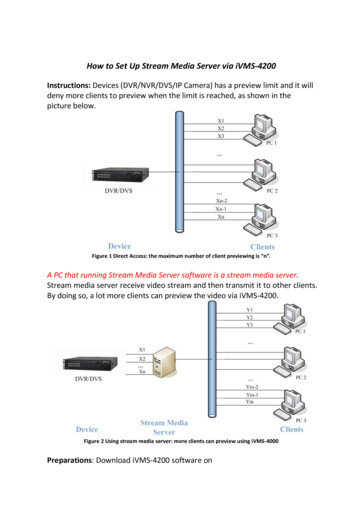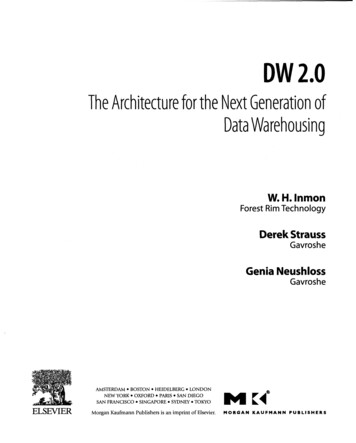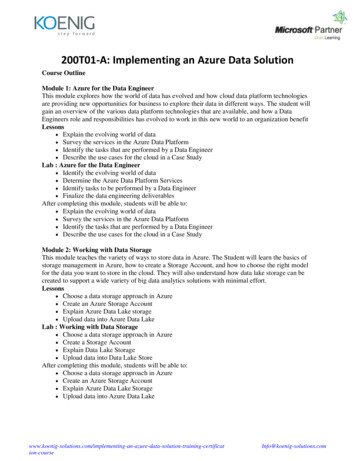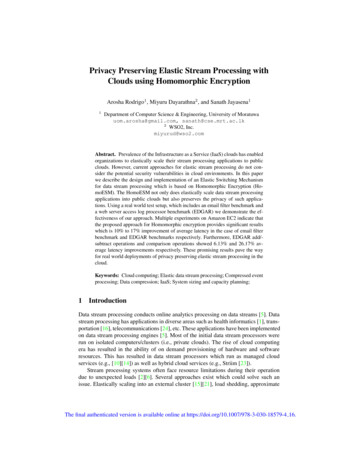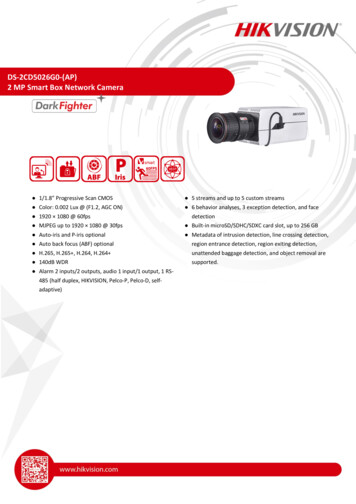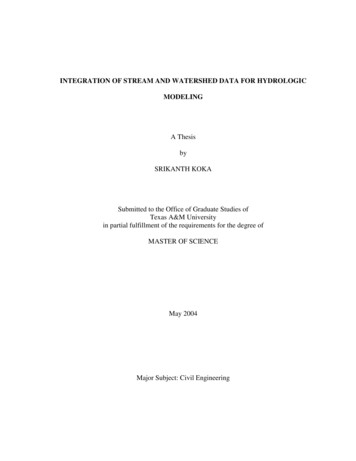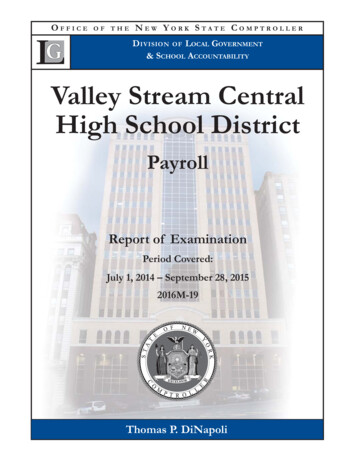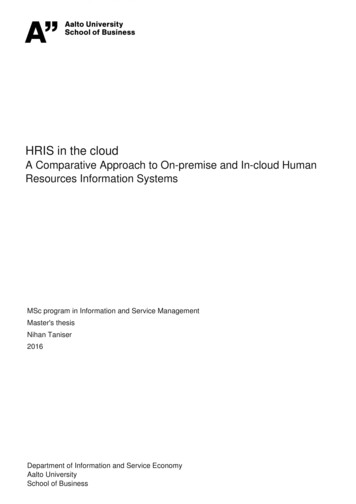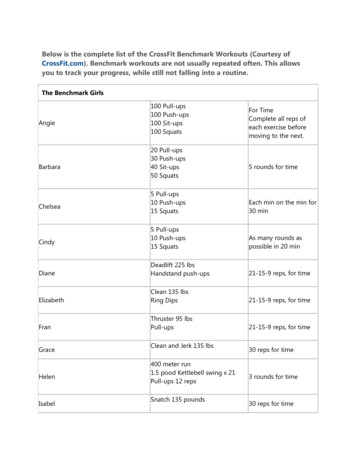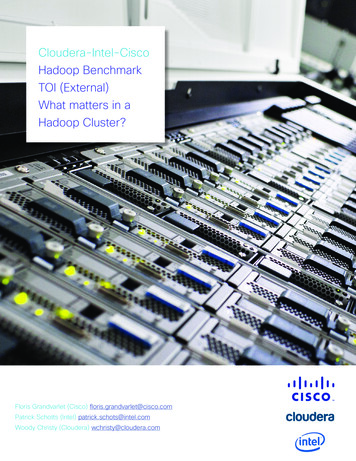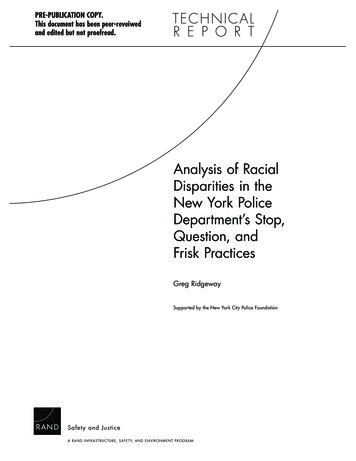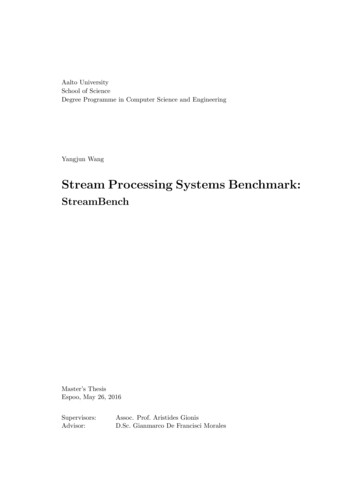
Transcription
Aalto UniversitySchool of ScienceDegree Programme in Computer Science and EngineeringYangjun WangStream Processing Systems Benchmark:StreamBenchMaster’s ThesisEspoo, May 26, 2016Supervisors:Advisor:Assoc. Prof. Aristides GionisD.Sc. Gianmarco De Francisci Morales
Aalto UniversitySchool of ScienceDegree Programme in Computer Science and EngineeringABSTRACT OFMASTER’S THESISAuthor:Yangjun WangTitle:Stream Processing Systems Benchmark: StreamBenchDate:May 26, 2016Pages: 59Major:Foundations of Advanced ComputingCode: SCI3014Supervisors:Assoc. Prof. Aristides GionisAdvisor:D.Sc. Gianmarco De Francisci MoralesBatch processing technologies (Such as MapReduce, Hive, Pig) have maturedand been widely used in the industry. These systems solved the issue processingbig volumes of data successfully. However, first big amount of data need to becollected and stored in a database or file system. That is very time-consuming.Then it takes time to finish batch processing analysis jobs before get any results.While there are many cases that need analysed results from unbounded sequenceof data in seconds or sub-seconds. To satisfy the increasing demand of processingsuch streaming data, several streaming processing systems are implemented andwidely adopted, such as Apache Storm, Apache Spark, IBM InfoSphere Streams,and Apache Flink. They all support online stream processing, high scalability,and tasks monitoring. While how to evaluate stream processing systems beforechoosing one in production development is an open question.In this thesis, we introduce StreamBench, a benchmark framework to facilitateperformance comparisons of stream processing systems. A common API component and a core set of workloads are defined. We implement the common APIand run benchmarks for three widely used open source stream processing systems:Apache Storm, Flink, and Spark Streaming. A key feature of the StreamBenchframework is that it is extensible – it supports easy definition of new workloads,in addition to making it easy to benchmark new stream processing systems.Keywords:Language:Big Data, Stream, Benchmark, Storm, Flink, SparkEnglishii
AcknowledgementsI would like to express my gratitude to my supervisor Aristides Gionis forproviding me this opportunity and introducing me to the topic. FurthermoreI would like to thank my advisor Gianmarco De Francisci Morales for all hisguidances and supports. His guidance helped me in all the time of researchand writing of this thesis. I could not have imagined having a better advisorfor my master thesis.Besides my advisors, I would like to thank all my friends in data mininggroup of Aalto university. Thanks for your advises and helps during mymaster study. It was a happy time to work with you and I have learnt a lotfrom you.Last but not least, I want thank my parents for trying to support mewith the best they can do all these years. A lot of thanks to all friends fortheir support and patience too.Espoo, May 26, 2016Yangjun Wangiii
Abbreviations and TPCAWSRDDDAGYARNAPIGBRAMUUIDDistribute File SystemCentral Processing UnitHadoop Distribute File SystemGoogle File SystemLocal Area NetworksYahoo Cloud Serving BenchmarkThe Portable Operating System InterfaceDataBase Management SystemTransaction Processing Performance CouncilAmazon Web ServicesResilient Distributed DatasetDirected Acyclic GraphYet Another Resource NegotiatorApplication Programming InterfaceGigabyteRandom Access MemoryUniversally Unique Identifieriv
ContentsAbbreviations and Acronymsiv1 Introduction12 Background2.1 Cloud Computing . . . . . . . . . . . . . . . . .2.1.1 Parallel Computing . . . . . . . . . . . .2.1.2 Computer Cluster . . . . . . . . . . . . .2.1.3 Batch Processing and Stream Processing2.1.4 MapReduce . . . . . . . . . . . . . . . .2.1.5 Hadoop Distribution File Systems . . . .2.1.6 Kafka . . . . . . . . . . . . . . . . . . .2.2 Benchmark . . . . . . . . . . . . . . . . . . . .2.2.1 Traditional Database Benchmarks . . . .2.2.2 Cloud Service Benchmarks . . . . . . . .2.2.3 Distributed Graph Benchmarks . . . . .2.2.4 Existing stream processing benchmarks2.2.5 The Yahoo Streaming Benchmark . . . .33455677910101112133 Stream Processing Platforms3.1 Apache Storm . . . . . . . . . . . . . . . . .3.1.1 Storm Architecture . . . . . . . . . .3.1.2 Computational Model . . . . . . . .3.2 Apache Flink . . . . . . . . . . . . . . . . .3.2.1 Flink Architecture . . . . . . . . . .3.2.2 Computational Model . . . . . . . .3.3 Apache Spark . . . . . . . . . . . . . . . . .3.3.1 Resilient Distributed Dataset(RDD)3.3.2 Computational Model . . . . . . . .3.3.3 Spark Streaming . . . . . . . . . . .3.4 Other Stream Processing Systems . . . . . .161718191920202122232424v.
3.4.13.4.2Apache Samza . . . . . . . . . . . . . . . . . . . . . . . 24Apache S4 . . . . . . . . . . . . . . . . . . . . . . . . . 264 Benchmark Design4.1 Architecture . . . . . . . . . . . .4.2 Experiment Environment Setup .4.3 Workloads . . . . . . . . . . . . .4.3.1 Basic Operators . . . . . .4.3.2 Join Operator . . . . . . .4.3.3 Iterate Operator . . . . .4.4 Data Generators . . . . . . . . .4.4.1 WordCount . . . . . . . .4.4.2 AdvClick . . . . . . . . .4.4.3 KMeans . . . . . . . . . .4.5 Experiment Logging and Statistic4.6 Extensibility . . . . . . . . . . . .272729293031343536363738395 Experiment5.1 WordCount . . . . . . . .5.1.1 Offline WordCount5.1.2 Online WordCount5.2 AdvClick . . . . . . . . . .5.3 K-Means . . . . . . . . . .5.4 Summary . . . . . . . . .41414243474952.6 Conclusion and Future Work536.1 Conclusion . . . . . . . . . . . . . . . . . . . . . . . . . . . . . 536.2 Future Work . . . . . . . . . . . . . . . . . . . . . . . . . . . . 54vi
List of Figures2.12.22.3Kafka producer and consumer [17] . . . . . . . . . . . . . . . . 8Kafka topic partitions . . . . . . . . . . . . . . . . . . . . . . 9Operations flow of YSB [44] . . . . . . . . . . . . . . . . . . . 133.13.23.33.43.53.63.7Stream processing model . . . .Storm cluster components . . .Flink computing model . . . . .Spark job stages[47] . . . . . . .Spark Streaming Model . . . . .Samza DataFlow Graph . . . .Samza and Hadoop reamBench architecture . . . . . . . . .Windowed WordCount . . . . . . . . . . .Window join scenario . . . . . . . . . . . .Spark Stream join without repeated tupleSpark Stream join with repeated tuples . .Stream k-means scenario . . . . . . . . . .Latency . . . . . . . . . . . . . . . . . . .283132333435395.15.25.35.45.55.65.75.8Throughput of Offline WordCount (words/second) . .Throughput Scale Comparison of Offline WordCountThroughput of work nodes (words/s) . . . . . . . . .Latency of Online WordCount . . . . . . . . . . . . .AdvClick Performance . . . . . . . . . . . . . . . . .KMeans Latency of Flink and Storm . . . . . . . . .Convergences . . . . . . . . . . . . . . . . . . . . . .Spark KMeans Latency . . . . . . . . . . . . . . . . .4243444547495051vii.
Chapter 1IntroductionAlong with the rapid development of information technology, the speed ofdata generation increases dramatically. To process and analysis such largeamount of data, the so-called Big Data, cloud computing technologies get aquick development, especially after these two papers related to MapReduceand BigTable published by Google [7, 12].In theory, Big Data doesn’t only mean “big” volume. Besides volume,Big Data also has two other important properties: velocity and variety [14].Velocity means the amount of data is growing at high speed. Variety refersto the various data formats. They are called three V s of Big Data. Whendealing with Big Data, there are two types of processing models to handledifferent kinds of data, batch processing and stream processing. Masses ofstructured and semi-structured historical data (Volume Variety) such asthe Internet Archive of Wikipedia that are usually stored in distribute file systems and processed with batch processing technologies. On the other hand,stream processing is used for fast data requirements (Velocity Variety)[45]. Some fast data streams such as twitter stream, bank transactions andweb page clicks are generated continuously in daily life.Batch processing is generally more concerned with throughput than latency of individual components of the computation. In batch processing,data is collected and stored in file system. When the size of data reaches athreshold, batch jobs could be configured to run without manual intervention, executing against entire dataset at scale in order to produce output inthe form of computational analyses and data files. Because of time consumein data collection and processing stage, depending on the size of the databeing processed and the computational power of the system, output can bedelayed significantly.Stream processing is required for many practical cases which demandanalysed results from streaming data in a very short latency. For example,1
CHAPTER 1. INTRODUCTION2an online shopping website would want give a customer accurate recommendations as soon as possible after the customer scans the website for a while.By analysing online transaction data stream, it is possible to detect creditcard fraud. Other cases like stock exchanges, sensor networks, and userbehaviour online analysis also have this demand. Several stream processingsystems are implemented and widely adopted, such as Apache Storm, ApacheSpark, IBM InfoSphere Streams and Apache Flink. They all support highscalable, real-time stream processing and fault detection.Industry standard benchmark is a common and widely accepted way toevaluate a set of similar systems. Benchmarks enable rapid advancementsin a field by having a standard reference for performance, and focus the attention of the research community on a common important task [40]. Forexample, TPC benchmarks such as TPC-C [10], TPC-H [11] have promotedthe development of database systems. TPC-C simulates a complete computing environment where a population of users executes transactions against adatabase. TPC-H gives a standard evaluation of measuring the performanceof highly-complex decision support databases.How to evaluate real time stream processing systems and select one fora specific case wisely is an open question. Before these real time streamprocessing systems are implemented, Stonebraker et al. demonstrated the 8requirements[43] of real-time stream processing, which gives us a standardto evaluate whether a real time stream processing system satisfies these requirements. Although some previous works [9, 15, 28, 38, 46] are done toevaluate a stream processing system or compare the performance of severalsystems, they check performance through system specific applications. Thereis no such a standard benchmark tool that evaluates stream processing systems with a common set of workloads. In this thesis, we introduce a benchmark framework called StreamBench to facilitate performance comparisonsof stream processing systems. The extensibility property of StreamBenchnot only enables us to implement new workloads to evaluate more aspectsof stream processing systems, but also allows extending to benchmark newstream processing systems.The main topic of this thesis is stream processing systems benchmark.First, cloud computing and benchmark technology background is introducedin Chapter 2. Chapter 3 presents architecture and main features of threewidely used stream processing systems: Storm, Flink and Spark Streaming.In Chapter 4, we demonstrate the design of our benchmark framework –StreamBench, including the whole architecture, test data generator and extensibility of StreamBench. Chapter 5 presents and compares experimentresults of three selected stream processing systems. At last, conclusions aregiven in Chapter 6.
Chapter 2BackgroundThe goal of this project is to build a benchmark framework for stream processing systems, which aim to solve issues related to Velocity and Varietyof big data [45]. In order to process continuously incoming data in a lowlatency, both the data and stream processing task have to be distributed.Usually the data is stored in a distributed storage system which consists ofa set of data nodes. A distributed storage system could be a distributed filesystem, for example HDFS demonstrated in § 2.1.5, or a distributed messaging system such as Kafka discussed in § 2.1.6. The stream processing taskis divided into a set of sub-tasks which are distributed in a computer cluster(see § 2.1.2). The nodes in a computer cluster read data from distributedstorage system and execute sub-tasks in parallel. Therefore, stream processing achieves both data parallelism and task parallelism of parallel computingwhich is discussed in § 2.1.1.In § 2.2, we present several widely accepted benchmarks of DBMS, cloudservices, and graph processing systems. There are many good features in thedesign and implementation of these benchmarks, and some of which could beused in our benchmark as well. At the end, we discuss an existing benchmarkof stream processing systems – The Yahoo Streaming Benchmark.2.1Cloud ComputingMany stream processing frameworks are run on the cloud such as GoogleCloud Dataflow, Amazon Kinesis, and Microsoft Azure Stream Analytics.Cloud computing, also known as “on-demand computing”, is a kind of Internetbased computing, where shared resources, data and information are providedto computers and other devices on-demand. It is a model for enabling ubiquitous, on-demand access to a shared pool of configurable computing resource3
CHAPTER 2. BACKGROUND4[32, 35]. Cloud computing and storage solutions provide users and enterpriseswith various capabilities to store and process their data in third-party datacenters [25]. Users could use computing and storage resources as need elastically and pay according to the amount of resources used. In another way,we could say cloud computing technologies is a collection of technologies toprovide elastic “pay as you go” computing. That include computing ability,scalable file system, data storage such as Amazon S3 and Dynamo, scalable processing such as MapReduce and Spark, visualization of computingresources and distributed consensus.2.1.1Parallel ComputingParallel computing is a computational way in which many calculations participate and simultaneously solve a computational problem, operating on theprinciple that large problems could be divided into smaller ones and smallerproblems could be solved at the same time. As mentioned in the beginningof this chapter, both data parallelism and task parallelism are achieved instream processing. Besides, base on the level of parallelism there are twoother types of parallel computing: bit-level parallelism and instruction-levelparallelism. In the case of bit-level and instruction-level parallelism, parallelism is transparent to the programmer. Compared to serial computation,parallel computing has the following features: multiple CPUs, distributedparts of the problem, and concurrent execution on each compute node. Because of these features, parallel computing could obtain better performancethan serial computing.Parallel computers can be roughly classified according to the level atwhich the hardware supports parallelism, with multi-core and multi-processorcomputers having multiple processing elements within a single machine, whileclusters, MPPs, and grids use multiple computers to work on the same task.Therefore, when the need for parallelism arises, there are two different ways todo that. The first way is “Scaling Up”, in which a single powerful computeris added with more CPU cores, more memory, and more hard disks. Theother way is dividing task between a large number of less powerful machineswith (relatively) slow CPUs, moderate memory amounts, moderate hard diskcounts, which is called “Scaling out”. Compare to “Scaling up”, “Scaling out”is more economically viable. Scalable cloud computing is trying to exploiting“Scaling Out” instead of “Scaling Up”.
CHAPTER 2. BACKGROUND2.1.25Computer ClusterThe “Scaling Out” strategy turns out computer cluster. A computer clusterconsists of a set of computers which are connected to each other and worktogether so that, in many respects, they can be viewed as a single system.The components of a cluster are usually connected to each other throughfast local area networks (“LAN”), with each node running its own instanceof an operating system. In most circumstances, all of the nodes use thesame hardware and operating system, and are set to perform the same task,controlled and scheduled by software. The large number of less powerfulmachines mentioned above is a computer cluster.One common kind of clusters is master-slave cluster which has two different types of nodes, master nodes and slave nodes. Generally, users onlyinteract with the master node which is a specific computer managing slavesand scheduling tasks. Slave nodes are not available to users that makes thewhole cluster as a single system.As the features of computing cluster demonstrated above, it is usuallyused to improve performance and availability over that of a single computer.In most cases, the average computing ability of a node is less than a single computer as scheduling and communication between nodes consume resources.2.1.3Batch Processing and Stream ProcessingAccording to the size of data processed per unit, processing model could beclassified to two categories: batch processing and stream processing. Batchprocessing is very efficient in processing high Volume data. Where data iscollected as a dataset, entered to the system, processed as a unit. The outputis another data set that can be reused for computation. Depending on thesize of the data being processed and the computational power of the computercluster, the latency of a task could be measured in minutes or more. Sincethe processing unit of batch processing is a dataset, any modification suchas incorporating new data of an existing dataset turns out a new dataset sothat the whole computation need start again. MapReduce and Spark are twowidely used batch processing models.In contrast, stream processing emphasizes on the Velocity of big data.It involves continual input and output of data. Each records in the datastream is processed as a unit. Therefore, data could be processed withinsmall time period or near real time. Streaming processing gives decisionmakers the ability to adjust to contingencies based on events and trendsdeveloping in real-time. Beside low-latency, another key feature of stream
CHAPTER 2. BACKGROUND6processing is incremental computation, whenever a piece of new data arrives,attempts to save time by only recomputing those outputs which “depend on”the incorporating data without recomputing from scratch.Except batch processing and stream processing, between them there isanother processing model called mini-batch processing. Instead of processing the streaming data one record at a time, mini-batch processing modeldiscretizes the streaming data into tiny, sub-second mini-batches. Each minibatch is processed as a batch task. As each batch is very small, mini-batchprocessing obtains much better latency performance than batch processing.LatencyThroughputPrior VBatchStreammins - hoursLargeVolumemilliseconds - secondsSmall(relatively)VelocityTable 2.1: Comparison of batch processing and stream process2.1.4MapReduceMapReduce is a parallel programming model and an associated implementation for processing and generating large data sets with a parallel, distributedalgorithm on a cluster of commodity hardware in a reliable, fault-tolerantmanner [12]. To achieve the goal, there are two primitive parallel methods, map and reduce, predefined in MapReduce programming model. AMapReduce job usually executes map tasks first to split the input data-setinto independent chunks and perform map operations on each chuck in acompletely parallel manner. In this step, MapReduce can take advantageof locality of data, processing it on or near the storage assets in order toreduce the distance over which it must be transmitted. The final outputs ofmap stage are shuffled as input of reduce tasks which performs a summaryoperation.Usually, the outputs of map stage are a set of key/value pairs. Then theoutputs are shuffled to reduce stage base on the key of each pair. The wholeprocess of MapReduce could be summarized as following 3 steps: Map: Each worker node reads data from cluster with lowest transmitcost and applies the “map” function to the local data, and writes theoutput to a temporary storage. Shuffle: Worker nodes redistribute data based on the output keys(produced by the “map” function), such that all data belonging to onekey is located on the same worker node.
CHAPTER 2. BACKGROUND7 Reduce: Worker nodes now process each group of output data, perkey, in parallel.One good and widely used MapReduce implementation is the Hadoop 1MapReduce [18] which consists of a single master JobTracker and one slaveTaskTracker per cluster-node. The programming models of many streamprocessing systems like Storm, Flink and Spark Streaming are all inspiredfrom MapReduce. Operators Map and Reduce are either built-in these systems or could be implemented with provided built-in APIs. For example,Flink supports Map, Reduce and some other MapReduce-inspired operationslike FlatMap, Filter by default. In Storm, all these mentioned operatorscould be implemented with APIs of Spout and Bolt.2.1.5Hadoop Distribution File SystemsHadoop Distributed File System [16] is open source clone of Google File System (GFS) [20] that is deployed on computing cluster. In Hadoop MapReduce framework, locality relies on Hadoop Distributed File System (HDFS)that can fairly divide input file into several splits across each worker in balance. In another word, MapReduce is built on the distributed file systemand executes read/write operations through distributed file system. HDFSis highly fault-tolerant and is designed to be deployed on low-cost hardware.HDFS provides high throughput access to application data and is suitable forapplications that have large data sets. HDFS relaxes a few POSIX requirements to enable streaming access to file system data [16]. The assumptionsand goals of HDFS include: hardware failure, high throughput, large dataset,streaming access, data load balance and simple coherency model, “MovingComputation is Cheaper than Moving Data”, and portability across heterogeneous hardware and software platforms.In general, HDFS and MapReduce usually work together. In a distributecluster, each data node in HDFS runs a TaskTracker as a slave node inMapReduce. MapReduce retrieves data from HDFS and executes computation and finally writes results back to HDFS.2.1.6KafkaApache Kafka is a high-throughput distributed publish-subscrib messing system which was originally developed by LinkedIn. Now it is one top levelproject of the Apache Software Foundation. It aims at providing a unified,high-throughput, low-latency platform for handling continuous data feeds.1http://hadoop.apache.org/
CHAPTER 2. BACKGROUND8Figure 2.1: Kafka producer and consumer [17]A stream processing system subscribing to Kafka will get notified within avery short time after a publisher published some data into a Kafka topic. InStreamBench, we use Kafka to provide messaging service. Before we go intoarchitecture of Kafka, there are some basic messaging terminologies [17]: Topic: Kafka maintains feeds of messages in categories called topics. Producer: Processes that publish messages to a Kafka topic are calledproducers. Consumer: Processes that subscribe to topics and process the feed ofpublished messages are consumers. Broker: Kafka is run as a cluster comprised of one or more serverseach of which is called a broker.As Figure 2.1 shown, producers send messages over the network to theKafka cluster which holds on to these records and hands them out to consumers. More specifically, producers publish their messages to a topic, andconsumers subscribe to one or more topics. Each topic could have multiplepartitions that are distributed over the servers in Kafka cluster, allowing atopic to hold more data than storage capacity of any server. Each partitionis replicated across a configurable number of servers for fault tolerance. Eachpartition is an ordered, immutable sequence of messages that is continuallyappended to a log. The messages in the partitions are each assigned a sequential id number called the offset that uniquely identifies each message withinthe partition. Figure 2.2 shows a producer process appending to the logs forthe two partitions, and a consumer reading from partitions sequentially.
CHAPTER 2. BACKGROUND9Figure 2.2: Kafka topic partitionsAt a high-level Kafka gives the following guarantees [17]: Messages sent by a producer to a particular topic partition will beappended in the order they are sent. That is, if a message M1 is sentby the same producer as a message M2, and M1 is sent first, then M1will have a lower offset than M2 and appear earlier in the log. A consumer instance sees messages in the order they are stored in thelog. For a topic with replication factor N, we will tolerate up to N-1 serverfailures without losing any messages committed to the log.Another very important feature of Kafka is messages with the same keywill be sent to the same partition. When a distributed application consumesdata from a kafka topic in parallel, data with the same key goes to the sameexecutor which could avoid data shuffle.2.2BenchmarkAs systems become more and more complex and thus complicated, it becomesmore and more difficult to compare the performance of various systems simply by looking at their specifications. For one kind of systems, there arealways a sequence of performance metrics which indicate the performanceof a specific system, such as average response time of a query in DBMS. Incomputing, a benchmark is the act of running a set of programs mimicking aparticular type of workload on a system, in order to assess the relative performance metrics of a system. Many benchmarks are designed and widelyused in industry to compare systems.
CHAPTER 2. BACKGROUND10In this Section, we discuss benchmarks for different computer systems:DBMS, Cloud Data Service and Graph Processing System. An existingbenchmark of Stream processing system developed by Yahoo is also presentin § 2.2.5.2.2.1Traditional Database BenchmarksTraditional database management systems are evaluated with industry standard benchmarks like TPC-C [10], TPC-H [11]. These have focused onsimulating complete business computing environment where plenty of usersexecute business oriented ad-hoc queries that involve transactions, big table scan, join, and aggregation. The queries and the data populating thedatabase have been chosen to have broad industry-wide relevance. Thisbenchmark illustrates decision support systems that examine large volumesof data, execute queries with a high degree of complexity, and give answersto critical business questions [11]. The integrity of the data is verified duringthe process of the execution of the benchmark to check whether the DBMScorrupt the data. If the data is corrupted, the benchmark measurement isrejected entirely [13]. Benchmark systems for DBMS mature, with data andworkloads simulating real common business use cases, they could evaluateperformance of DBMS very well. Some other works were done related tospecific business model.Linkbench [5] benchmarks database systems which store “social network”data specifically. The workloads of database operations are based on Facebook’s production workload and the data is also generated in such a waythat key properties of the data match the production social graph data inFacebook. LinkBench provides a realistic and challenging test for persistentstorage of social and web service data.2.2.2Cloud Service BenchmarksAs the data size keep increasing, traditional database management systemscould not handle some use cases with very big size data very well. To solvethis issue, there are plenty of NoSQL database systems developed for clouddata serving. With the widespread use of such cloud services, several benchmarks are introduced to evaluate these cloud systems.One widely used and accepted extensible cloud serving benchmark namedYahoo! Cloud Servicing Benchmark (YCSB) developed by Yahoo [8]. It proposes two benchmark tiers for evaluating the performance and scalability ofcloud data serving systems such as Cassandra, HBase, and CouchDB. A coreset of workloads are developed to evaluate different tradeoffs of cloud serving
CHAPTER 2. BACKGROUND11systems. Such as write/read heavy workloads to determine whether systemis write optimised or read optimised. To evaluate transaction features inlater NoSQL database, YCSB T [13] extends YCSB with a specific workload for transaction called Closed Economy Workload(CEW). A validationphase is added to the workload executor to check consistency of these clouddatabases. YCSB [39] is another set of extensions of YCSB to benchmark other five advance features of cloud databases such as bulk insertions,server-
such streaming data, several streaming processing systems are implemented and widely adopted, such as Apache Storm, Apache Spark, IBM InfoSphere Streams, and Apache Flink. They all support online stream processing, high scalability, and tasks monitoring. While how to evaluate stream processing systems before
